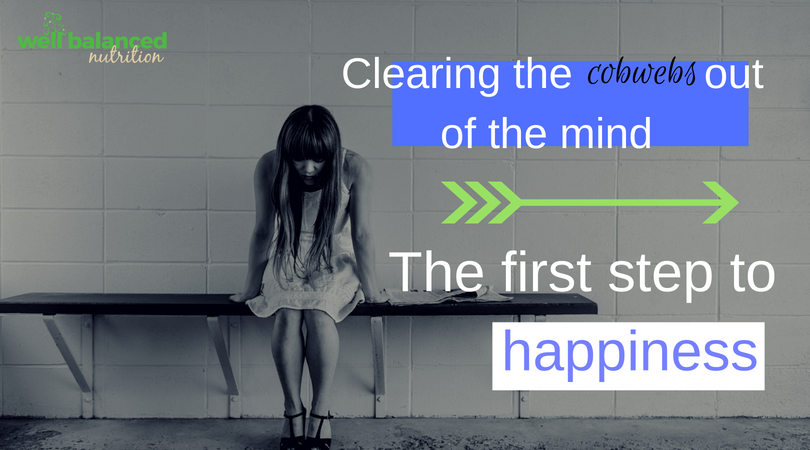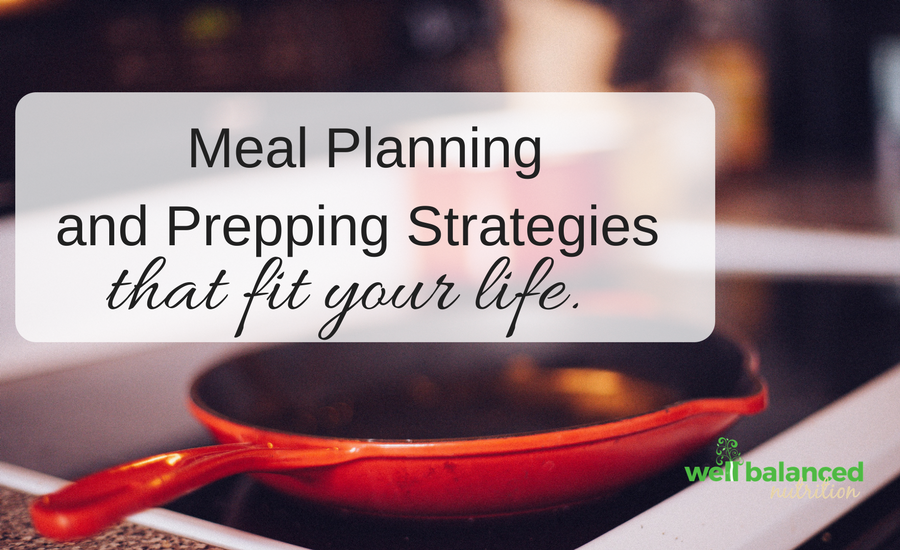
by Lucy | Aug 21, 2018 | Well Balanced Wisdom
Why me? It’s not fair. How did this happen? For 1 in 5 American’s suffering from irritable bowel syndrome (IBS), these are common thoughts and questions that cross the mind. Maybe after a weekend of eating out and enjoying food with friends and family suddenly, cramping, bloating, and discomfort takes over the gut and all you can do is curl up and wait until it passes.
Most of my life I was blessed to eat anything I wanted – I joke that I grew up on Ramen noodles, Pop-tarts, and a lot of chicken casseroles (including broccoli and cauliflower!).
Then came 2012
For 7 years prior to 2012, I was practicing a flexitarian diet, which for me included eating mostly plant-based foods such beans, tofu, peanut butter, and I even started eating lentils. Unfortunately, in November 2012 I contracted a stomach virus. It included a lot of pain and bloating for about five weeks and I lost weight, which at my size was not healthy. When that was over I tried to resume my normal diet. This consisted of salads, plenty of broccoli, apples, and other delicious colorful foods. The problem was some of those same symptoms I had during the virus stated to crop up unexpectedly in the middle of the day or after dinner. More pain. More bloating. But no more virus. I spoke with a good friend (also a dietitian) who recommended I look at eliminating the FODMAP foods – stands for Fermentable Oligosaccharides, Disaccharides, Monosaccharides, and Polyols. For anyone unfamiliar these are foods that have a particular kind of naturally occurring sugar, which are linked to some cases of IBS. She was right! When I stopped eating apples I stopped feeling awful after lunch, at least for a little while. Then by May 2016 while traveling up to Michigan to see my honey I hit a wall (not literally!), but I got fed up with feeling awful. I decided it was time to find out once and for all what was causing my gut issues. I went on an anti-inflammatory elimination diet. These come in all shapes and sizes – I gave up many common culprits including grains, dairy, fermented foods, and legumes. Gasp! At this point you might be thinking “what did you eat?!” For anyone that has done a Whole30 you know that fruits, vegetables, and meat/seafood become the bulk of what you are consuming. During that time, I discovered almond butter isn’t so bad and coconut flour is very versatile and delicious. Otherwise, I started to recognize and address my emotional relationship with food. Turns out, a lot of IBS symptoms are heavily influenced by the gut-brain connection and can be affected heavily by stress and hormones.
So many pity parties
During the first elimination I only committed to 21 days because I knew it was going to be challenging. I learned a lot about my habits, but I did it didn’t give me any conclusive information about what was causing my symptoms. Luckily, my lovely brilliant business partner, Kristen Norton, introduced me to MRT or mediator release testing option, which I did in February 2017. This blood test shows the inflammatory response your body has to 170 foods/chemicals. The test revealed some surprising information, which lead to a significant change in my diet and lifestyle for the next 18 months (and counting). In the beginning, when I first got my results I cut down to eating from a list of 30 approved non-inflammatory foods. Considering on average we consume 700 to 1000 foods and chemicals each week this was a very creative time for me. Who knew all the different ways you could prepare rice, sweet potatoes, tilapia, and carrots?
After the MRT results I was informed that alcohol is a huge trigger for IBS symptoms or flare-ups and was advised to stop drinking at least for the first month. Oh, the pity parties. I quickly learned that Friday was a huge trigger for having an alcoholic beverage. I kid you not, it wasn’t until October 13, 2017 that I was finally journaled my first Friday in 8 months that I didn’t crave an adult beverage on Friday night. I promise I don’t have a drinking problem, it was a groove in my brain (aka habit) formed starting in college and apparently became a way of life for the following decade. Not to mention, some of my other favorites I needed to stop eating like lettuce, soy-products, and Duke’s mayonnaise (darn paprika and lemon juice). I cried a lot those first several weeks. Yet, I was finally able to truly empathize with my clients who are doing even harder things in the name of their health and well-being.
What’s the lesson?
While this is still a hard subject for me to talk about, I feel so much better now than I did when I was eating in a way that wasn’t serving my body. Our mission at Well Balanced Nutrition is teach, empower, and connect women that want to feel confident in their food choices and bodies. My body was telling me that my old flexitarian diet was no longer serving me. Our bodies are talking to us all the time. The trick is learning to tune in, listen with compassion, and sometimes swim against the stream to make changes necessary feel our best.
Food for thought
What is your body telling you? The first step is tuning in. Next, I encourage everyone to spend time thinking about what better feels like. How will your life change when you feel better?
Lastly, you don’t have to do this alone. We can help.


by Lucy | Jul 8, 2018 | Well Balanced Wisdom
The other morning I was reading a great book by Kate Northrup titled Money: A Love Story. This is not your typical financial planning book. Instead, it’s an opportunity to take a mindful journey to understand and develop a healthier relationship with money. Northrup goes on to explain there are a lot of feelings and emotions around money and anybody that says otherwise is not being truthful with themselves.
Kristen and I would venture to say the same thing about food. When somebody is having issues making a change their diet, I have to tell them it’s rarely about the food. For instance, if you find yourself craving comfort foods, we may suggest that you are in need of more connection and/or love (or a good nights sleep!). We tend to seek comfort in the form of food if we feel isolated, disappointment, sad, overwhelmed, etc. Other healthier coping tools would include volunteering, calling a friend, playing with your furry or not-so-furry child or taking a walk.
As I continued reading and journaling, as prompted by Northrup, I suddenly had the urge to check my bank account. That is when I realized all the money for rent was still sitting in the bank account, which means I was at least two days late paying our rent. *palm to the face* Luckily, I was in full fledge observation mode and just started journaling my thoughts in that very moment. Do you know what I’ve discovered? I am a jerk face to myself! I was instantly telling myself that I’m an idiot and I should know better. So it was demoralizing and unproductive.
As a person who fancies herself as self-aware, it was incredibly surprising to have this bombardment of negative self talk flood my mind. Soon there were tears and I felt even more ridiculous for crying over $50. Seriously.
Fast forward to a few hours later and I’m walking through the woods.… Catching cobwebs. It got me thinking that these negative thought patterns are kind of like cobwebs in our minds. We’ve built them in without even realizing that they are making this journey to happy and healthy a lot less pleasant.
The first step
Today I’m encouraging each of you to just notice when you have a negative thought run through your mind. Anything such as, “you idiot!” Or “you should have…” Or “you know better. Why do you keep making the same mistake?!”

We now know that this is self shaming and as Brene Brown reminds us shame corrodes the part of the brain that believes that we can change. In short, shame does not help you do better. In fact, it will probably perpetuate the same negative behaviors. When we notice the negative thought patterns we can start to change them. I often teach friends and clients to try Cancel. Cancel. Cancel. when they first notice the negativity. Then create a helpful mantra or affirmation to replace the thoughts. Sometimes it can be as simple as repeating “release.” Or as Northrup mentions in her book, “I am pure, calm grace.” Important note: the affirmation needs to resonate with you. That means when you find an uplifting quote or phrase make sure it is speaking your truth. Do you believe and embody it?
Food for thought:
It always seems easier to help others recognize these negative thought patterns. Do you have a friend or loved one that you trust that could help you see where you might be allowing these negative thought patterns and cobwebs of the mind to hold you back?
Kristen and I are happy to help you clear the way and make a more enjoyable journey into your happy and healthy – let us know how we can help?


by Lucy | May 3, 2018 | Nutrition Questions Answered, Well Balanced Wisdom
Before going out to for Italian food with friends, Lisa thought she would order the baked chicken parmesan with a salad. Once at the restaurant, hungry and exhausted from an overwhelming workweek, she ordered the ooey gooey cheesy lasagna and ate it all. Then, Lisa woke up the next morning two pounds heavier and feeling shame and guilt wash over her. If you found yourself relying on willpower to make your healthy food choices you may have had a similar experience. This often comes from a diet mentality. It’s the thought pattern ‘as long as I can be good I will be able to [fill in the blank],’ that leads us to drain the willpower tank because we overthink every decision and default into old habits.
At the beginning of each day, most of us wake up feeling confident and determined “today’s the day, I’m going to be healthy!” As we go throughout the day making thousands of decisions and using our mental and physical energy, our tank may get depleted. That is when you find yourself craving something crunchy, salty or sweet around 3 PM (or if you’re like me it’s at 9 PM). Either way, we know willpower is not the solution to living a healthy Well-Balanced life.
3 steps to keep your willpower tank full
- Notice when you’re relying on willpower. Recognize that little voice in your head saying; no, I won’t eat the free bagels in the break room today. Yep, that is good old willpower going to work for you. There is some evidence that states, I won’t statements deplete our willpower more rapidly. First, notice when you are denying yourself something that your brain is craving. Kristen describes it as riding the crave wave. It is okay because most cravings pass.
- Replace ‘I won’t’ with ‘I want.’ Once you’ve noticed the I won’t, you can start to change your thoughts to include ‘I want [something better that will help me reach my goals].’ For instance, if your brain saying I won’t eat the leftover cake that someone brought to work, instead, I want my delicious egg muffins and fruit smoothie, because it gives me the energy I need to do my job. Or simply I want to eat Well-Balanced and I know those donuts will just lead me to a sugar crash and make me feel awful later.
- Create a new normal – aka automation. Research claims up to 95% of all we do is subconscious. Think about the last time you took a shower. Did you stop and think ‘Now I pour the soap. Now I wash my hair. Now I shave my legs…’ Unlikely! It just happens, right? Same goes for food. Our brains are designed to keep us alive, not help us reach our ultimate health and well-being. When the brain senses energy-dense foods, like cheese and French fries, it sends signals to keep eating in case you experience scarcity or famine. Setting up healthier habits, such as packing a sandwich with baby carrots and an orange for lunch instead of relying on whatever you can find near the office will eliminate the task of making another decision.
Food for thought:
Is a diet mentality holding you back? It is common – even socially acceptable and encouraged – to reward ourselves with a special treat. This behavior pattern may have started in childhood when our well-meaning teachers or caretakers would supply candy or snack foods for good behavior. On the road to Well Balanced, there is an important step in recognizing what habits are holding us back. We invite you to take the Diet Mentality Assessment to pinpoint where your downfalls might be sabotaging your health, weight, and wellness goals.


by Lucy | Apr 24, 2018 | Well Balanced Wisdom
I never played sports; therefore, the coaching concept is new to me. At Grace Church, pastor Kendrick recently taught us about people who struggle without improvement versus people who grow and develop in the midst of their struggles. He put it bluntly, when we are in performance mentality and seeking the approval or acceptance of others, we become prideful. A performance mentality is sometimes rooted in insecurity because the ego doesn’t like to be wrong or embarrassed. When Michael Jordan got cut from the high school varsity basketball team as a sophomore he was devastated; however, instead of throwing in the towel on his dreams he hit the courts and practiced, practiced, and practiced some more.
Some of our clients assume Kristen and I will give them a meal plan, a few recipes, and maybe a cheer to keep them on track. Instead, they get a coach – someone to listen, give feedback, and provide a toolbox of skills to live a happy and healthy lifestyle.
In order to grow and get better, here are five steps to becoming more coachable and achieve your ultimate health and well-being.
5 steps to achieve your goals
- It always starts with a vision. Sports enthusiast and professionals spend time envisioning themselves succeeding. For instance, when a golfer steps up to the tee, she will envision the ball going in the direction and landing exactly where she wants it to be. If she steps up to the ball and starts thinking about something else or looking into the sandpit, that’s where the ball goes. What is the vision of your healthiest self look like? What are your habits? How do you feel?
- Next, comes skills development. If you’ve never hit a golf ball, it’s unlikely that it will go very far or exactly in the direction you were hoping the first time you play. Instead, you start by learning which golf club to use, the appropriate grip, the right stance, and the swing. Same idea if you’re unfamiliar with how to cook and assemble Well Balanced meals. First, we need to start with what is well-balanced? Then how plan meals to meet your nutritional needs.
- Put it into action! Now we apply our new skills. On the golf course that may mean going to hit a bucket of balls at the range. For someone looking to become healthier, it could be planning a week of Well Balanced dinners for the family.
- Grow. It’s OK to fall down, it’s OK to not succeed. Each time we “fail,” is a chance to learn how not to do it next time. So what if you swung the golf club and missed the ball by inches? Sounds like the time to laugh it off and try again. And if you had cereal for dinner last night (again), perhaps it’s a good chance to stock up on a few of our favorite Quick Fix Meal ideas.
- Lastly, we need to be humble! That means if you keep trying and it’s not working it’s time to ask for help. It could be time to hire an instructor and get on the greens for guided practice or several. And if you’ve tried diet after diet with the same results we invite you to apply for a Breakthrough the Diet Mentality call.
Food for thought
Most of us have two voices that sometimes go to battle in our heads… “I got this!” and “why bother?“ That second voice is just our ego trying to protect itself. Instead, listen to the helping and encouraging thoughts – create a vision, practice the healthy habits, and get back on if you fall off the wagon. And if you need some help in the kitchen, you know where to find us: contact Lucy & Kristen.


by Lucy | Apr 17, 2018 | Well Balanced Wisdom
Have you ever thought to yourself ‘If only I had more willpower, then I could be healthy and lose weight?’ You are not alone. As nutritionists, we talk to many people who assume they are weak and lacking in willpower. That’s why they haven’t been able to stop going to Chick-fil-A after work or eat just one handful of mixed nuts instead of half the container. To boost willpower, we need to start with the understanding that willpower is an unreliable resource affected by the number of decisions we’ve made, temptations we face, and even the mood we are in.
Why willpower runs out:
Willpower can easily be overused and depleted if we aren’t careful. Think of willpower as a gas tank in a car. Maintaining steady blood-sugar levels by eating well-balanced meals and snacks regularly (aka keeping it full of quality fuel), keeps our willpower levels high. Also setting up healthier environments and habits can help us rely less on willpower and more on cruise control. Without steady fuel and good habits in place, we can quickly burn through our “tank of willpower” before noon.
For instance, if someone arrives to work without eating breakfast and finds themselves at a meeting with free biscuits, they are more likely to grab the free food. On the flip side, another coworker who routinely eats a Well-Balanced breakfast consisting of an egg sandwich and an apple is less likely to feel tempted by the same biscuits.
How to boost your willpower:
Keep your willpower tank full by saving your willpower for emergencies, rather than everyday moments. The 3 steps to keeping your tank full are:
- Setting up cruise control: creating healthy attainable habits and not relying on willpower alone to achieve your goals.
- Selecting high-quality fuel: including a positive self-image and attitude, as well as, incorporating proper nutrition at regular meals.
- Avoiding rough roads: avoiding temptation when possible and putting strategies in place that help you manage the situation when temptation might arise.
Food for thought:
Sometimes willpower is the tool you need in the moment. More often, we need to find other ways to make healthy choices. Are you relying too much on willpower? Take this quiz to find out where you stand with willpower and get additional strategies for making the healthier choice more often.

For additional support and personalized wellness plans, please contact us 🙂


by Lucy | Mar 25, 2018 | Meal Planning, Well Balanced Wisdom
Meal planning and prepping take effort, skill and time, which makes it a bit challenging. The good news is that strategies and solutions exist to suit everyone’s needs. Let’s dive into your tendencies and your situation and how you could leverage them to your advantage. Below I make suggestions based on your tendency. If you don’t know what your tendency is, please read this blog post first.
Upholders – Since upholders readily meet expectations and get things done, they would do well with a meal planning service. Everything from the recipes to the grocery lists is done for you which can save you a lot of time. There are many options and a few of my favorites include Super Healthy Kids Meal Plans (done by registered dietitians and family friendly), My Happy Plates (a local company, includes grocery delivery service), No More to Go (has 3 options: cooking-for-2, gluten-free and family).
Obligers readily meet outer expectations that others impose but struggle to meet the inner expectations they want to impose on themselves. Therefore, they must find creative ways to set up some external accountability. Meal prepping partners or groups can keep obligers motivated and can be a ton of fun. Who wouldn’t enjoy cooking with your friends or neighbors and drinking wine while prepping your meals? Your group can meet weekly like in this plan or you can select a few freezer meals that can be pulled out at any time. Here is a great done-for-you meal prep party plan that includes recipes and all.
Furthermore, obligers tend to be motivated to do things that benefit others. These ideas could help:
- Have a reoccurring dinner date with a friend where you take turns cooking.
- Commit to bringing a home cooked meal to a neighbor or friend. Double the recipe so you can eat it too.
- View the responsibility of meal planning and prepping as something important you want to role model for your children.
- Make a pact with your bestie that you can’t do X until you’ve meal planned and prepped for the week and ask them to hold you to your word.
Questioners like to do the research, decide for themselves, customize things to fit their needs and act with good reason. Questioners will do well if they’ve already made their mind up to meal plan and prep. If they haven’t, they might need to explore why meal planning is important to them. Done-for-you meal planning services could work well, but it is likely questioners will want to customize it to their style and preferences. They will only stick to it if the plan is logical and efficient, which could simply take a little trial, error, and tweaking to suit their needs.
Rebels – do best when they take it one day at a time. They may want to keep a stocked kitchen and have several meal ideas that can be thrown together in a pinch. Having a loose plan, such as 3-4 meal ideas for the week is better than having a specific dinner for a specific day of the week (which could also be true for some questioners and obligers).
Hate to cook? – Clean-eatz is perfect for those who just want someone to cook for them. Another idea is to trade services with their friends that do enjoy to cook. For instance, a mom of young kids who likes to be in the kitchen but doesn’t have the distraction-free time to do so could pair up with a mom who hates to cook but would love to play with the kids.
Cooking for one? Cereal for dinner again? You can do better! It’s really easy to slack off at dinner time when you only have your own mouth to feed. Using the above strategies like inviting a friend, cooking for someone else or having a meal prep party might work well for you.
Hate leftovers? When cooking for one, finding the right recipes is important. You probably get turned off by most recipes you see because you’d be eating the same thing for DAYS. I really love this roundup of healthy single-serving meals and I think you will, too.
Food for thought:
There is no one-size-fits-all approach to meal planning and prepping, but it’s an important part of healthy eating. Without at least a little forethought, you’ll be eating cereal or fast food most nights. Thinking about your unique style, situation and needs can help you find the strategies that work. This will take some trial and error. The important thing is that you keep making an effort to choose nourishing foods that meet your health goals. It doesn’t have to be perfect and it may look different each week, but what matters is that you are putting in the effort continuously. That’s when you finally find your groove. Just don’t give up.











